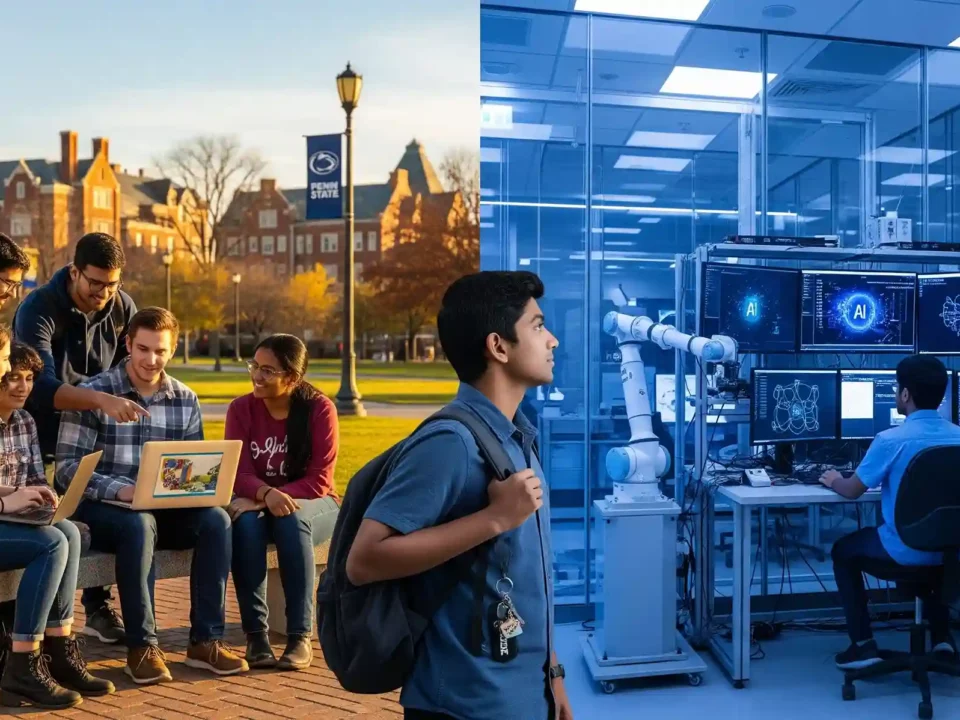USA vs Australia: Which is Better for Indian Students?

USA vs Australia: Which is Better for Indian Students?
In the realm of higher education, the USA and Australia have emerged as formidable contenders for Indian students seeking academic excellence and cultural enrichment. Beyond the allure of scenic beauty and travel adventures, both countries host renowned universities that beckon ambitious Indian minds. So, which one holds the edge for Indian students? Let's delve into the comparison.
Top Universities
Both the USA and Australia boast world-class institutions. The USA flaunts over 5,300 universities, with 10 in the top 20 globally, while Australia houses 42 universities, including 3 in the top 20. Here's a glance at the top 10 universities along with their average tuition fees:
| Top Universities | Average UG Tuition Fee | Average PG Tuition Fee |
|---|---|---|
| USA | ||
| Harvard University | INR 40L - INR 45L | INR 16L - INR 62L |
| Stanford University | INR 45L - INR 52L | INR 42L - INR 45L |
| Massachusetts Institute of Technology (MIT) | INR 50L | INR 25L |
| University of California, Berkeley | INR 44L | INR 30.6L |
| Australia | ||
| The University of Melbourne | INR 22L | INR 25L |
| The University of New South Wales (UNSW Sydney) | INR 17L | INR 28L |
| The University of Sydney | INR 16L | INR 20L |
Top Courses
Both countries offer diverse courses catering to various academic interests. Here's a comparative overview of the top 10 courses:
| Top Courses in Australia | Top Courses in the USA |
|---|---|
| Nursing | Communication & Media Studies |
| Computer Science Engineering | Business Administration |
| Cybersecurity | Computer Science |
| Automotive | Engineering |
| Architecture | Data Science & Analytics |
| Bachelors in accounting | Public Policy |
| Psychology | Marketing |
| Sociology | Public Policy |
| Agriculture Science | Healthcare Management |
| Tourism and Hospitality Management | Finance |
Eligibility Requirements
Meeting the eligibility criteria is crucial for admission. Here's a comparison:
| Eligibility Requirements | Australia | USA |
|---|---|---|
| Completed secondary education or equivalent | ✔️ | ✔️ |
| Meet English language proficiency requirement | Minimum IELTS score of 6.5 | Minimum IELTS score of 6.5 |
| Standardised tests | Not mandatory for most undergrad programs; GRE/GMAT may be required for some grad programs | SAT, ACT, GRE, or GMAT may be required depending on the program |
| Financial stability | Proof of financial funds | Proof of financial funds |
Cost of Living
The cost of living varies, with the USA slightly higher on average:
| Costs | Avg Cost in Australia | Avg Cost in the USA |
|---|---|---|
| Mobile Phone | INR 2,300 (AUD 43) | INR 4,300 ($ 52) |
| Internet | INR 4,500 (AUD 85) | INR 5,930 ($ 71) |
| Transportation Monthly Pass | INR 9,000 (AUD 170.65) | INR 6,000 ($ 72) |
| Basic Utilities | INR 18,000 (AUD 334) | INR 17,200 ($ 206) |
| Rent in City Centre | INR 1.27L (AUD 2,377) | INR 1.5L ($ 1775) |
Scholarships
Both countries offer scholarships to ease financial burdens:
|
Top Scholarships in Australia |
Top Scholarships in USA |
|
Australian Leadership Awards |
Fulbright Scholarship |
|
South Asia Excellence Scholarship |
Inlaks Shivdasani Foundation Scholarships |
|
Monash International Scholarship For Excellence |
Tata Scholarships |
Average Salaries
While the USA generally offers higher salaries, the cost of living is also higher:
| Jobs | Avg salary in Australia | Avg salary in the USA |
|---|---|---|
| Teacher | INR 50.8L (AUD 94,750) | INR 35L ($41,923) |
| Accountant | INR 48L (AUD 90,000) | INR 73.3L ($87,851) |
| Data Analyst | INR 50L (AUD 92,500) | INR 75L ($ 89,903) |
| Marketing Manager | INR 96L (AUD 1,79,000) | INR 90L ($ 1,07,948) |
Visa Requirements
Visa processes differ:
| Parameters | Australia | USA |
|---|---|---|
| Visa | Subclass 500 | F-1 Student Visa |
| Cost | INR 38,000 (AUD 710) | INR 13,363 ($ 160) |
| Processing Time | 1 – 11 months | 10 days – 1 year |
PR Process
Both countries have distinct PR pathways:
In the USA, it's known as a Green Card, while in Australia, it's a Permanent Residency Visa.
PR Process in the USA:
In the USA, obtaining Permanent Residency, commonly known as a Green Card, is a significant milestone for international students wishing to settle permanently in the country. There are several pathways to obtaining a Green Card, each with its own set of eligibility criteria:
-
Employment-Based Green Card: This pathway is for individuals with specific job skills that are in demand in the USA. Employment-based Green Cards are divided into several categories, including EB-1 for priority workers, EB-2 for professionals with advanced degrees or exceptional abilities, and EB-3 for skilled workers, professionals, and unskilled workers.
-
Family-Based Green Card: This pathway allows individuals to obtain a Green Card through a family member who is either a US citizen or a lawful permanent resident. Immediate relatives of US citizens, such as spouses, parents, and unmarried children under 21, have higher priority in the family-based immigration system.
-
Diversity Visa (DV) Lottery: The DV Lottery, also known as the Green Card Lottery, is a program that provides a limited number of immigrant visas to individuals from countries with historically low rates of immigration to the USA. Winners of the DV Lottery can apply for a Green Card and eventually obtain Permanent Residency.
The process of obtaining a Green Card in the USA involves multiple steps, including:
- Filing the appropriate immigration petition or application with the United States Citizenship and Immigration Services (USCIS).
- Waiting for the petition/application to be processed and approved.
- If applying from outside the USA, attending a visa interview at a US embassy or consulate.
- Undergoing background checks and medical examinations.
- Upon approval, receiving a Green Card, which grants lawful permanent residency status in the USA.
It's important to note that the Green Card application process can be complex and time-consuming, with processing times varying depending on the specific immigration category and other factors.
PR Process in Australia:
In Australia, obtaining Permanent Residency is also a significant goal for international students looking to settle in the country permanently. The pathway to Permanent Residency in Australia is primarily through the General Skilled Migration (GSM) program, which is points-based and designed to attract skilled workers to fill labor shortages in the Australian economy.
The key steps in the PR process in Australia include:
-
Skill Assessment: Applicants must have their skills assessed by a relevant assessing authority to determine their suitability for their nominated occupation. The assessment process varies depending on the applicant's occupation and the assessing authority.
-
Expression of Interest (EOI): Eligible applicants must submit an Expression of Interest (EOI) through the online SkillSelect system, indicating their interest in applying for a skilled visa and providing information about their skills, qualifications, and work experience.
-
Invitation to Apply: Based on their EOI, applicants may receive an invitation to apply for a skilled visa if they meet the relevant points threshold and their occupation is in demand. The points are awarded based on factors such as age, English language proficiency, work experience, and qualifications.
-
Visa Application: Once invited to apply, applicants must lodge a visa application within the specified timeframe and provide supporting documentation, including proof of English language proficiency, health and character assessments, and evidence of financial capacity.
-
Visa Grant: If the visa application is approved, the applicant and their family members will be granted a Permanent Residency visa, allowing them to live, work, and study in Australia indefinitely. Permanent Residents also have access to Medicare (Australia's public healthcare system) and can apply for Australian citizenship after meeting the eligibility criteria.
Overall, the PR process in Australia is also rigorous and involves meeting specific requirements and criteria to be eligible for Permanent Residency. It's essential for applicants to carefully assess their options and seek professional advice if needed to navigate the process successfully.
Conclusion
Both the USA and Australia present compelling opportunities for Indian students. While the USA offers higher average salaries, Australia provides a relatively lower cost of living. The choice ultimately hinges on individual priorities, career goals, and lifestyle preferences.
Ready to take the next step?
At bluehawks, we understand that navigating the complexities of international education can be overwhelming. That's why our expert team is here to support you every step of the way.
From personalized consultations to comprehensive test preparation resources, we offer a range of services designed to help you achieve your academic goals. Whether you're facing challenges with language proficiency or need guidance on selecting the right university, our team is dedicated to providing you with invaluable advice and assistance.
Don't let language barriers or financial concerns hold you back from pursuing your dreams. Contact bluehawks today and let us help you chart your course to a brighter, more fulfilling future.



